Breaking News
17 Best Kitchen Cabinet Cleaners and Degreasers: Revive Your Cabinets’ Brilliance.
Your kitchen functions as the central hub of your home, and its cabinets play a crucial role by offering storage and elevating the overall visual appeal. However, as time goes on, these cabinets can gradually lose their shine due to the accumulation of grease, dirt, and the natural effects of daily usage.
Thankfully, there exists a remedy: specialized cleaners and polishes designed for kitchen cabinets. Within this blog post, we will delve into the realm of kitchen cabinet cleaners.
We’ll examine the diverse array of finishes, the functions of kitchen cabinet cleaners and polishes, optimal product selection strategies, and a stepwise approach to conducting thorough cleaning and polishing sessions.
By the end of this post, you’ll be equipped with comprehensive insights to breathe new life into your kitchen cabinets, restoring their original radiance.
Appreciating the Significance of Cabinet Upkeep:
The Visual Influence of Cabinets.
Your kitchen cabinets fulfill both utilitarian and aesthetic roles. They provide a space for storing culinary equipment, dishes, and pantry staples while substantially contributing to the overall visual charm of your kitchen space. Clean and well-cared-for cabinets have the potential to augment the atmosphere, while cabinets lacking attention can detract from it.
Consequences of Routine Usage
The day-to-day utilization of your kitchen subjects cabinets to a range of factors that can gradually mar their appearance. Grease splashes, fingerprints, and moisture are among the common culprits. Consistent upkeep is imperative to counteract these challenges.
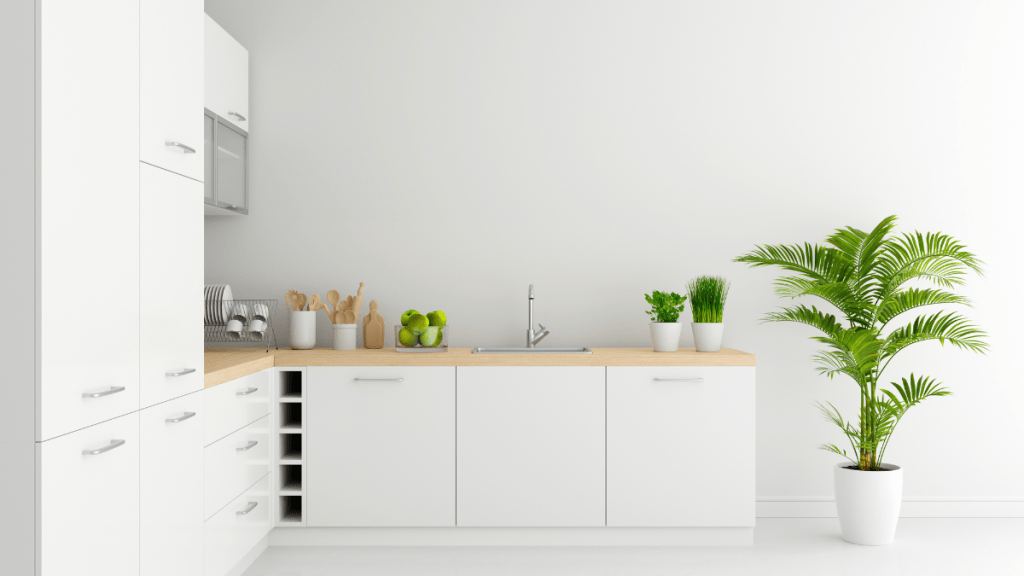
Best Kitchen Cabinet Cleaners:
Cleaning kitchen cabinets is essential for maintaining a clean and healthy kitchen environment. Here are some common types of kitchen cabinet cleaners and their specific uses:
- Vinegar: Vinegar is a natural and effective kitchen cabinet cleaner, suitable for removing grease and grime from kitchen cabinets. Mix equal parts of vinegar and water in a spray bottle, spray the solution on the cabinets, and wipe them down with a clean cloth.
- Baking Soda: Baking soda is another natural kitchen cabinet cleaner for removing stains and odors from cabinets. Create a paste by mixing baking soda with water, apply it to the cabinets, and scrub gently with a soft-bristled brush.
- Dish Soap: Dish soap is effective at removing food stains from cabinets. Mix it with warm water in a spray bottle, spray the solution on the cabinets, and wipe them down with a clean cloth.
- Oil Soap: Oil soap is specifically for cleaning wooden kitchen cabinets. It is excellent for removing dirt and grime without harming the wood. Dilute it with water according to the manufacturer’s instructions, apply the solution, and wipe the cabinets clean with a cloth.
- All-Purpose Cleaner: All-purpose kitchen cabinet cleaners are versatile and suitable for various kitchen surfaces, including cabinets. They work well for tackling tough stains. Spray the cleaner on the cabinets, let it sit for a few minutes, and then wipe it away with a clean cloth.
When selecting kitchen cabinet cleaners, consider these factors:
- Cabinet Material: Different cabinet materials may require specific cleaning methods. For wood cabinets, use oil soap, while all-purpose cleaners are suitable for others.
- Desired Cleanliness: The level of dirt and grime may dictate your choice. Heavy-duty cleaning may require all-purpose cleaners or a combination of baking soda and vinegar.
- Personal Preferences: Some prefer natural cleaners like vinegar and baking soda, while others opt for commercial cleaners based on their sensitivities or allergies.
- Maintenance: Regular cleaning is essential to keep your cabinets in good condition. Consider a cleaning schedule.
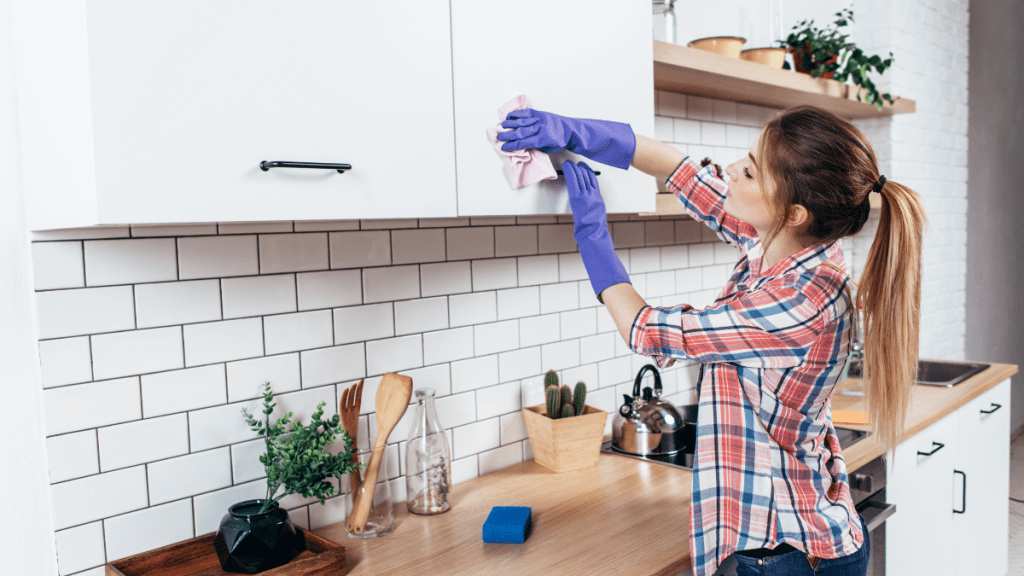
Best Kitchen Cabinet Grease Remover:
For effectively removing grease from kitchen cabinets, consider the following options:
- Simple Green Industrial Cleaner & Degreaser: This non-toxic and biodegradable formula is excellent for cutting through kitchen grease and grime on cabinets and countertops.
- Zep Heavy Duty Foaming Citrus Degreaser: This foaming degreaser effectively removes stubborn grease and grime from kitchen appliances, cabinets, and countertops.
- GP66 Green Miracle Cleaner: An eco-friendly option, this all-purpose cleaner can tackle tough stains and grease on kitchen cabinets.
Best Kitchen Cabinet Cleaner and Polish:
For cleaning and polishing wooden cabinets to restore their shine and protect against stains, consider these options:
- Parker and Bailey Kitchen Cabinet Cream: This non-toxic cream restores shine, protects against watermarks, and effectively cleans and polishes kitchen cabinets.
- Hope’s Perfect Cleaner: Ideal for wooden cabinets, it gently removes dirt and grime while leaving a protective finish. Note that it may not be suitable for painted cabinets.
- Old English Cleaner and Polish: Another option for wooden cabinets, it effectively removes dirt and grime while providing a protective finish. It may not be suitable for painted cabinets.
- Murphy’s Oil Soap: Specifically designed for wooden cabinets, this soap cleans, removes dirt, and leaves a protective finish.
Best Degreasers for Kitchen Cabinets:
If you’re looking for a dedicated degreaser for your kitchen cabinets, consider these options:
- Click here to Buy Simple Green Industrial Cleaner & Degreaser.
- Click here to Buy Zep Heavy Duty Foaming Citrus Degreaser.
- Click here to Buy GP66 Green Miracle Cleaner.
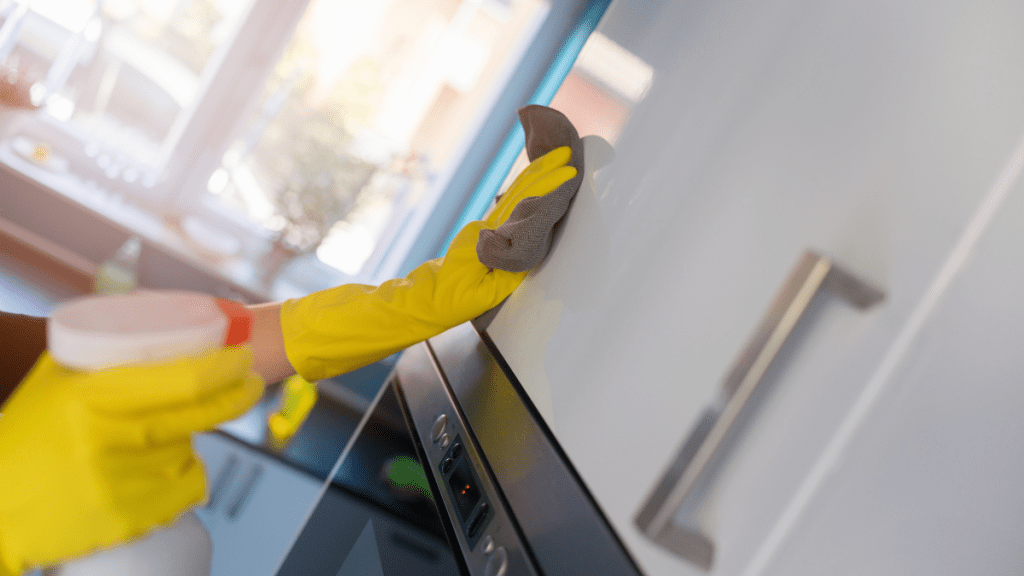
7 kitchen cabinet degreasers:
1. KH-7 Ultimate Grease Remover: A versatile solution suitable for grills, tires, and fabrics. Its merits encompass rapid grease dissolution, water-based composition devoid of phosphates or harsh agents, and food-safe use on counters and cookware. Notably, it might not be optimal for specific materials like leather, wool, or dyed fabrics.
2. Lysol Kitchen Pro Cleanser: Crafted for comprehensive disinfection, including kitchen cabinets. Its advantages encompass affordability, adeptness in grease and grime elimination, and potent antibacterial and antiviral properties. However, potential downsides involve the presence of chemicals that might adversely affect certain surfaces.
3. Krud Kutter Original Stain Eraser: Engineered to eliminate robust stains and grease from diverse surfaces, including kitchen cabinets. Its strengths involve versatility, compatibility with wood, laminate, and painted cabinets, and a residual protective layer. Yet, it might necessitate extra effort for tenacious stains.
4. Green Gobbler Concentrated Orange Oil: A natural cleanser for grease and grime, it is a must-have as a kitchen cabinet cleaner. Its merits lie in eco-friendliness, non-toxic formulation, and safety around children and pets. Nevertheless, effectiveness on specific surfaces, like stainless steel, could be limited.
5. Method Intense Grease Cleaner: Devised to combat tough stains and grease on various surfaces, including kitchen cabinets. Its virtues comprise eco-consciousness, non-toxic attributes, and an appealing fragrance. Nonetheless, optimal results might not be achievable on all surfaces.
6. Zep Heavy-Duty Degreaser: Engineered to vanquish stubborn stains and grease on different surfaces, including kitchen cabinets. Its strengths encompass potent efficacy, versatility across floors, walls, and countertops, but potential drawbacks involve the presence of chemicals detrimental to specific materials.
7. Bon Ami Gentle Powder Cleanser: Tailored for non-abrasive cleansing, suitable for kitchen cabinets. Its positives include effective dirt removal sans scratching, eco-friendliness, non-toxicity, and absence of harsh agents. However, persistent stains might require extra application effort.
Step-by-Step Guide to Deep Clean Your Cabinets
- Gathering Supplies: Before you begin, gather microfiber cloths, a vacuum with a brush attachment, a bucket, vinegar, baking soda, dish soap, and a soft-bristle brush.
- Removing Cabinet Contents: Empty the cabinets to access all surfaces easily. This is also a perfect time to declutter and reorganize your items.
- Surface Dusting and Cobweb Removal: Use a vacuum’s brush attachment to gently remove dust and cobwebs from corners and crevices. Follow up with a microfiber cloth to wipe down all surfaces.
- Grease and Grime Removal: Create a mixture of vinegar and water, and gently scrub cabinet surfaces using a soft-bristle brush. For stubborn grease, make a paste with baking soda and water, apply it, and let it sit before scrubbing.
- Polishing and Final Touches: After cleaning, wipe down the cabinets with a clean, damp cloth. For wooden cabinets, apply a furniture polish to restore the shine.
- Maintaining Your Cabinets for Longevity: Regular maintenance is key to prolonging the life of your cabinets. Wipe down surfaces weekly and address spills promptly to prevent staining.
- Tips to Prevent Future Buildup: To minimize future buildup, consider using shelf liners, storing items in airtight containers, and wiping down cabinet doors and handles regularly.
- Choosing the Right Cleaning Schedule: The cleaning frequency depends on factors like cooking frequency and kitchen traffic. Generally, a deep clean every few months with regular upkeep suffices.
- Reviving Old Cabinets: A Makeover: If your cabinets have lost their luster, a makeover might be in order. Sanding, repainting, or refinishing can transform old cabinets into stunning focal points.
- The Role of Cabinet Organization: Effective organization not only makes your cabinets visually appealing but also helps you utilize space efficiently. Consider using dividers, pull-out shelves, and hooks.
- Common Mistakes to Avoid: Avoid abrasive cleaners, steel wool, and harsh scrubbing, as these can damage the cabinet’s finish. Additionally, never leave excess moisture on wooden surfaces.
- Enhancing Different Cabinet Materials: Wood, Metal, Laminate: Different cabinet materials require specific care. Wooden cabinets need conditioning, metal cabinets benefit from rust prevention techniques, and laminate cabinets require gentle cleaning.
- Cabinet Hardware: Cleaning and Maintenance- Don’t forget the hardware! Clean handles and knobs with a mild solution and tighten loose screws to keep everything functional.
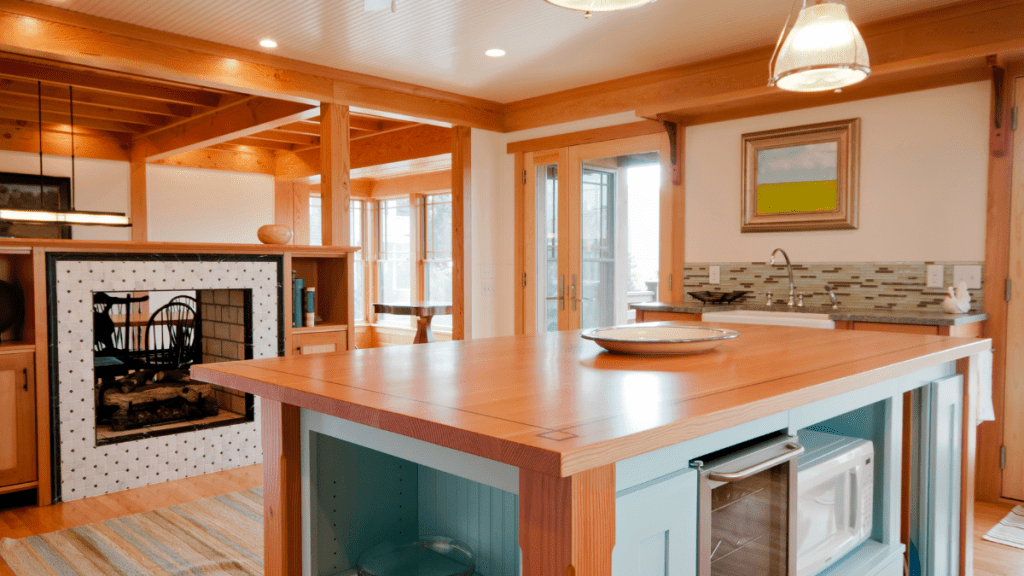
Recipe for a DIY Kitchen Cabinet Cleanser:
Ingredients:
- 1 cup of white vinegar
- 1 cup of water
- 1 tablespoon of baking soda
- A few drops of dish soap (optional)
- An empty, clean spray bottle
- A microfiber or gentle cleaning cloth
Instructions:
- In a clean container, blend equal parts with white vinegar and water. If your kitchen cabinets have excessive grease, slightly increase the amount of vinegar.
- To combat stubborn grease or sticky residues, incorporate 1 tablespoon of baking soda into the vinegar-water mixture. This aids in breaking down grime.
- Optionally, you can introduce a few drops of dish soap to the blend. Dish soap effectively tackles grease, but exercise caution, not to overuse it, as it may leave a soapy residue.
- Carefully pour this mixture into a clean spray bottle, ensuring the bottle is thoroughly clean to prevent contamination.
- Before commencing cleaning, eliminate loose dirt or dust from cabinet surfaces using a soft cloth or a dry sponge.
- Apply the homemade cleaner evenly onto the cabinet surfaces you intend to clean by spraying.
- Allow the cleaner to sit for a minute or two, permitting it to dissolve any grease or grime.
- Gently scrub the cabinet surfaces using a soft cloth, sponge, or a soft-bristle brush. For stubborn stains or sticky residues, you might need to exert a bit more pressure.
- Wipe down the cabinets with a clean, damp cloth to eliminate any remaining cleaner.
- Dry the cabinets with a separate clean, dry cloth to prevent streaks or water spots.
- If required, repeat the process for any areas that still appear soiled.
- Once your cabinets are clean and dry, revel in their revitalized appearance!
Always exercise caution and test this homemade cleanser on a small, inconspicuous area of your cabinets initially to ensure it doesn’t harm the finish. This natural cleaning solution is suitable for most kitchen cabinet materials, including wood, laminate, and painted surfaces.
Summary:
Preserving both the allure and practicality of your kitchen cabinets is pivotal for establishing an inviting and well-organized space. Irrespective of whether your cabinets are wooden, laminated, or painted, adhering to consistent cleaning and upkeep routines guarantees their longevity and enduring appeal.
With a grasp of your cabinet material’s unique requirements, astute selection of suitable cleaning agents, and adherence to proper cleansing methods, you can seamlessly restore the splendor and sophistication of your kitchen cabinets. Maintain this diligence to not only enhance your home’s aesthetic but also to cultivate a more gratifying cooking and meal preparation atmosphere.
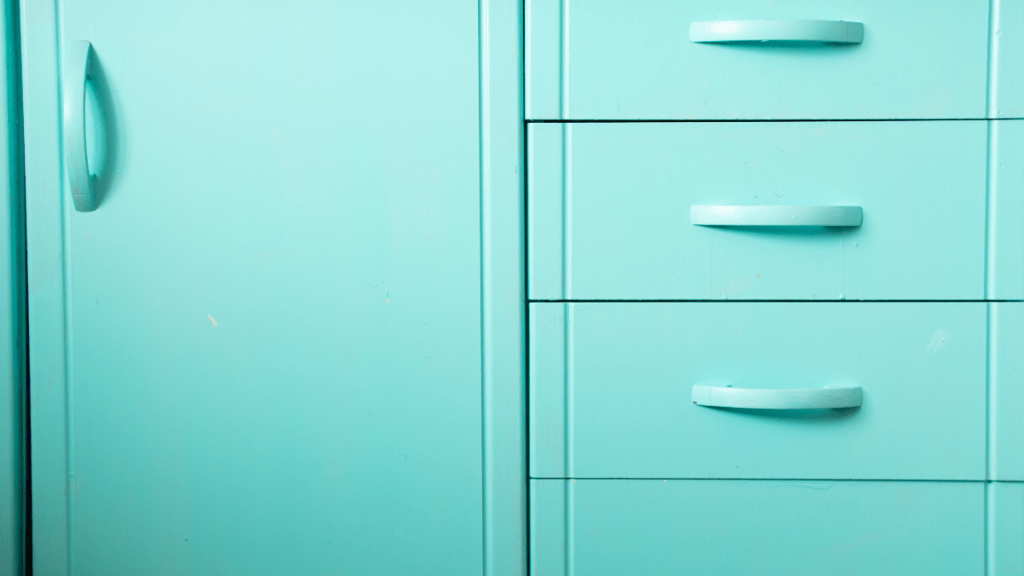
Frequently Asked Queries (FAQs):
- Why is cabinet maintenance essential for my kitchen?
Routine cabinet care is pivotal as cabinets hold both storage functionality and a prominent visual status within your kitchen. Over time, the accumulation of grease, dirt, and grime can tarnish their appearance and overall ambiance. - How do I determine my kitchen cabinets’ finish?
Deducing the finish involves examining the texture and appearance. Distinct finishes include wood, laminate, and paint. Tactile and visual cues aid in ascertaining the specific finish. - Can any kitchen cabinet cleaner be used on my cabinets?
No, it’s imperative to employ cleansers tailored for cabinets. Kitchen cabinet cleaners are devised to eliminate grease, dirt, and blemishes without causing harm. Avoid harsh chemicals that could potentially damage the cabinet surface. - Are homemade kitchen cabinet cleaners as potent as commercial ones?
Homemade cleaners, like vinegar and baking soda solutions, can be efficacious for gentle cleansing. However, for obstinate grease and grime, store-bought cleansers might yield superior outcomes. - How frequently should I cleanse and polish my cabinets?
The frequency of cleaning and polishing hinges on factors such as usage and kitchen environment. Generally, comprehensive cleaning every few months accompanied by routine wipe-downs proves sufficient. Polishing can be performed less often. - Can cabinet polish be applied to any cabinet material?
Cabinet polish is effective on wood and select laminates. However, it’s prudent to consult the manufacturer’s recommendations and initially test the polish in an inconspicuous spot to verify compatibility. - Can I preclude future buildup on my cabinets?
Certainly, preventive measures entail using shelf liners, storing items in airtight containers, and regularly wiping down cabinet surfaces, including doors and handles. This curbs the accumulation of dirt and grease. - How can I manage obstinate stains on my cabinets?
Stubborn stains can be addressed using natural elements like baking soda or a vinegar-water blend. Gently scrub the stained area with a soft cloth or delicate brush. - Can the same cleaner be used for painted and wooden cabinets?
Different cabinet materials necessitate tailored care. Although mild cleaners might suffice for both, selecting cleansers designed for the specific material ensures optimal results and prevents harm. - Are safety precautions imperative when employing kitchen cabinet cleaners?
Yes, always adhere to the cleaner’s instructions on the label. Ensure proper ventilation during usage and consider wearing gloves, particularly when dealing with potent products. - Can polish be applied immediately after cleaning?
It’s advisable to wait until the cabinets are completely dry before applying polish. This guarantees the optimal adherence and efficacy of the polish. - Can kitchen cabinet cleaners and polishes be applied to hardware as well? Indeed, mild solutions can be utilized to cleanse cabinet hardware. However, exercise caution with abrasive cleansers, as they might mar the hardware’s finish.
- Can cleaning and polishing revive aged cabinets?
Yes, cleaning and polishing can rejuvenate older cabinets, rendering them fresher and more appealing. For extensively worn cabinets, additional steps like sanding and refinishing might be required. - Can the same kitchen cabinet cleaner be used for both the interior and exterior of cabinets?
Yes, a uniform cleaner can be employed for both interior and exterior surfaces. Yet, consider diluting the solution for interior cleaning to avert oversaturation and material distortion. - Can kitchen cabinet cleaners harm the environment?
Numerous kitchen cabinet cleaners now offer environmentally conscious options with biodegradable components. Verify labels for endorsements like “Green Seal” to ensure eco-responsibility. - How do I address water spots on my cabinets?
A blend of equal parts water and vinegar can effectively combat water spots. Gently wipe the spotted area and subsequently dry it with a clean cloth. - Can I apply oil-based polish to all wood types?
Although oil-based polishes suit many wood types, specific exotic woods might necessitate specialized products. Always consult the manufacturer’s advice for optimal outcomes. - How can streaks be prevented when applying polish?
To avert streaking, employ polish along the wood grain’s direction using a soft cloth. Gently buff after the polish has fully dried to achieve a streak-free sheen. - Can a degreaser be utilized on all cabinet types?
Degreasers generally work well on diverse cabinet materials, yet selecting a degreaser compatible with your cabinet finish is imperative. Prior testing in an inconspicuous area is recommended. - Is it safe to employ a degreaser near food preparation zones?
Once thoroughly rinsed off, most kitchen cabinet degreasers are designed to be safe in proximity to food preparation areas. Nonetheless, reading product labels and adhering to instructions is paramount.